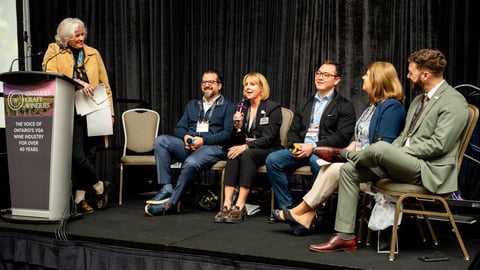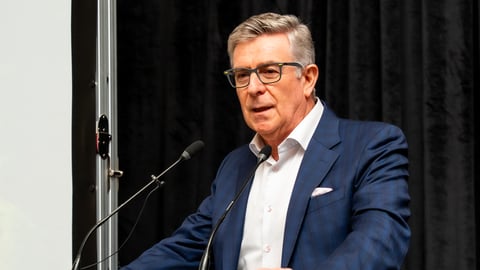Shoppers in Canada still willing to splurge on food, despite concerns about spending
Canadians rank among the most worried globally about the rising cost of everyday items, according to Deloitte’s ConsumerSignals study.
Still, even as affordability anxiety grows thanks to trade tensions and inflation, many consumers turn to food and beverage for comfort and indulgence, despite otherwise engaging in frugal grocery shopping purchases.
The monthly tracking finds 82% of Canadians are worried about rising prices—tied with Portugal and trailing only South Africa (84%) and Spain (83%). By contrast, concern is lower in the U.K. (77%), U.S. (76%) and India (74%).
“Canada is actually starting to creep up to the top of the rankings, which is not great,” said Ryan Robinson, senior research leader at Deloitte at the Ontario Craft Wine Conference & Trade Show in Niagara Falls on April 23, where he presented the research.
He was joined on stage by Gregory Jack, senior vice-president of public affairs at Ipsos Canada, in a session titled “Economic Uncertainty: Impacts on Ontario’s Craft Wine Industry.” Toronto Star business reporter Josh Rubin moderated.
A ranking of about 17 countries, the ConsumerSignals study surveys about 1,000 people in each country on how they’re managing their day-to-day finances and adjusting their spending habits.
Robinson noted that 60% of Canadian consumers expect alcohol and tobacco prices to rise in the months ahead.
As well, Deloitte’s Food Frugality Index, a monthly measure of cost-saving behaviours at the grocery store, found Canadian consumers are especially cautious—posting a score of 104 in March, compared to 95.8 in the U.S. and a global average of 96.3.
Higher scores indicate higher levels of frugality.
Frugal habits on the rise in Canada include purchasing lower-cost meats or cuts (34%, up a percentage point from February); reducing food waste at home (51%, up three percentage points); and only buying essentials (37%, up three percentage points).
In addition, 29% are sticking to store brands and 23% are buying less than they would normally. Those figures were unchanged from the previous month.
Yet when Canadians do treat themselves, they’re overwhelmingly choosing food and drink. Some 42% say they’re willing to splurge in this category—outpacing clothing and accessories (27%), personal care (9%), toys and hobbies (8%), electronics (7%) and health and wellness (3%).
According to Robinson, the top reasons for those indulgent purchases are to feel a sense of comfort (22%) and relaxation (16%)—a reminder that even when economic worries are high, people crave a little pleasure on their plates.
Navigating uncertainty
To navigate this, Robinson shared a checklist of questions, including:
• What cost management strategies can I use to mitigate the impact of higher input costs?
• Do I have the right data to support mitigation efforts, and is it accurate?
• Do I have the right resources in place to support critical activities including data gathering and monitoring?
• What supplier management strategies do I need to employ to ensure operational stability?
Patriotic purchasing and ‘maple-washing’
Jack also shared research and insights from Ipsos into how Canadians are feeling about the future of the country.
Most Canadians (67%) said the country’s future is better served by aligning with likeminded nations in Europe rather than the U.S.
Over the past two weeks, it also found patriotic purchasing on the rise, with 65% of Canadians buying more Canadian-made products. Meanwhile, 55% said they are either buying fewer or stopping altogether purchases of U.S. products.
And despite economic stresses, nearly three-quarters of Canadians say they’re knowingly paying more to buy Canada, with 21% indicating “for most of my purchases.”
However, brands need to be careful about how they position their product in today’s tariff war environment.
More than half of consumers (57%) said they would stop purchasing from a company if they discovered it was exaggerating how “Canadian” its products or services truly are.
Quebecors were found to be the most tolerant Canadians on this point, as fewer (42%) would stop a purchase of a product or service thought to be exaggerating their claims. By contrast, western Canadians are least tolerant, with the likelihood to stop buying those products highest in B.C. and Alberta (67% and 62%, respectively).
“We call it ‘maple washing’—brands that imply they’re Canadian but aren’t, and [they are] being punished by consumers [for it],” says Jack. “They see that as almost worse than just saying you’re proudly not Canadian and trying to sell goods honestly.”
For Canadian brands, what messaging drives home that homegrown message most persuasively?
“Made in Canada” was found to be the most impactful product claim (49% of Canadians), followed by “Product of Canada” (45%), “Grown in Canada” (41%), “Supported by Canadian farmers” (21%), “Prepared in Canada” (10%) and “Made in Canada from domestic and imported ingredients.”



